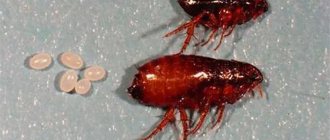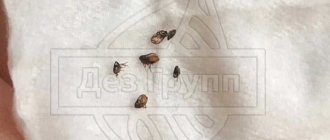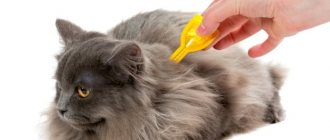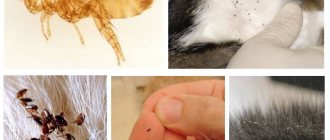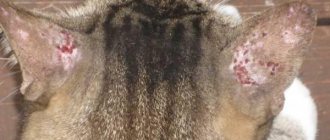Currently, pet stores have a large selection of products for getting rid of insects from adult cats. But how to remove fleas from a kitten? This task is not easy, since it is not recommended to treat babies with traditional medications intended for adult animals. The kitten is constantly licked by the mother, and the medicine, entering the cat’s esophagus, then ends up in her milk, which can cause much more harm to the baby than fleas.
In this regard, there are differences in the methods of removing fleas from newborn kittens and those whose age is 1 month or more.
Where do fleas come from in the house?
Fleas are very prolific: over 2 years of life, the female lays about 500 eggs, which after 2 weeks begin a full life and active reproduction. Insects need a source of food and a place to lay eggs. Therefore, they strive to penetrate the nest of a wild animal - a rabbit or a squirrel, or into a city apartment. How do they do this?
- a pet brings one or more insects from the street on its fur;
- flea eggs are carried into the apartment on the soles of shoes;
- fleas enter the apartment from neighbors;
- insects from the basement or attic can penetrate into nearby apartments
Causes and symptoms of fleas in cats
Fleas appear in cats when they are infected by other animals. In this case, there may not be direct contact. Parasite larvae can be carried home on shoes. After getting on the pet’s fur, they quickly hatch and actively reproduce. Fleas can cause dermatitis, in which the cat begins to itch, characteristic rashes and damage to the skin appear. Such parasites feed on the capillary blood of the animal, and their saliva is a strong allergen that provokes the described reactions.
Fleas in cats can multiply quickly and cause itching.
Fleas are very easy to recognize. If they are present, the pet itches all the time and may shake its head. Most cats experience decreased appetite, weight loss, and sleep disturbances. In addition, fleas are carriers of helminths, which provoke severe disturbances in the functioning of the pet’s body. To detect parasites, it is enough to move apart a few hairs. Particular attention should be paid to the withers area; as a rule, there are the most fleas there. The parasite resembles a black or brown miniature midge that jumps high and also moves very quickly.
The flea feeds on the pet's capillary blood
Attention! Don't underestimate the presence of fleas. Such blood-sucking parasites can cause diseases not only in pets, but also in people. At the same time, fleas can carry such dangerous pathologies as typhoid, salmonellosis and hepatitis virus.
Getting Rid of Fleas: 5 Steps to Insect Freedom
The difficulty in removing fleas from an apartment is that they multiply very quickly. Treating individual surfaces does not help: pupae remain in other places, which become fleas, bite a person or animal, and you have to start the fight again. Fleas live on the floor, under baseboards, in beds and other objects located at a height of no more than one and a half meters.
Start your room treatment by fighting your pet's fleas. The animal must be washed with a special shampoo, and then treated with a spray and put on an insecticidal collar.
How to get rid of fleas: treating an apartment
- Wash all bedding and bedspreads at a temperature of 60C and above. Wash your dog bed, cat house or mattress too, and if this is not possible, throw it away.
- Vacuum carpets and upholstered furniture. Don't forget about all the rugs and rugs that lie on the floor and hang on the walls. Immediately after cleaning, empty the contents of the vacuum cleaner into the toilet or take the tightly tied bag outside before the insects scatter.
- Wash the floor with water and added wormwood essential oil. Insect eggs will be washed away, and they will not lay new ones on the surface with the smell of wormwood for some time. Particular care should be taken to wash corners, baseboards and the floor under furniture.
- It is better to throw away all things that cannot be cleaned and washed. If fleas live in an old chair and lay eggs there, it will be a constant source of parasites.
- Wash all outdoor shoes thoroughly with a sponge and detergent. Then you can be sure that there will be no flea eggs left on your soles.
Preventive measures
After ridding the animal and housing of fleas, the main question arises - how to prevent re-infestation. Unfortunately, there is a possibility of insects being introduced due to reasons beyond our control. However, there are a number of measures that, if observed, will help minimize the risk of reappearance of parasites:
- maintain order in the house, clean, wash and shake out cat litter;
- with the beginning of the spring-summer season, protect your pet from fleas using special means (collars, drops, sprays, etc.);
- try to limit your cat’s contact with infected animals.
Such very simple methods can save you and your ward from a lot of hassle in the fight against fleas. After all, it is much easier to prevent a threat than to deal with its consequences.
Review of effective anti-flea products for home and animals
The flea is tenacious. A powerful chitinous shell - an exoskeleton - protects it from mechanical damage and exposure to chemicals. But there are insecticides that affect the nervous system of insects, destroy the chitinous shell and bring inevitable death to them. Such products should contain the following substances:
- Pyrethrins are natural insecticides that are safe for human and animal health. The insect is paralyzed, after which it dies;
- pyrethroids (permethrin, cypermethrin, deltamethrin, etc.) are synthetic pesticides with a stronger effect than pyrethrins. Negatively affects the nervous system of domestic animals and fish;
- Imidacloprid is a neonicotinoid pesticide. Analog of pyrethroids;
- Nitenpyram is a medicine taken orally. Kills fleas in a maximum of 1.5 hours. Safe for humans and animals;
- Selamectin is a semi-synthetic agent. Not used for treating pregnant and lactating animals, puppies, kittens and sick individuals;
- fipronil is a product for treating animal hair.
Insecticides for flea control: which weapon to choose?
The desire to get rid of insects should not end in poisoning a person or pets. Before use, you must study the instructions, calculate the dosage and, if necessary, isolate animals and children during treatment.
Anti-flea products for home
The indoor use of organophosphorus compounds such as dichlorvos, karbofos, chlorpyrifos, chlorophos, and the like is an unjustified risk. Yes, they are effective, but at the same time very dangerous for humans.
Sprays based on dichlorvos are inexpensive, but you should focus not only on the price. What else can you find on the insecticide market:
- Sinusan is a product with a strong unpleasant odor based on chlorpyrifos. Professional exterminators work with it. Spray while wearing a respirator, safety glasses and gloves;
- Get – granular chlorpyrifos concentrate for home use. They often sell products that are not original, and therefore ineffective.
Effective pyrethroid sprays to kill fleas
Synthetic pyrethroid insecticides are conveniently used in the form of a spray or aerosol. Analogues of natural pyrethrins are not inferior to them in their insecticidal properties, but are safe for humans and pets. The undeniable advantage of aerosols is that adult insects and larvae are destroyed in one treatment.
When using a flea spray or aerosol, you must:
- clear the room of people and pets. Cover the aquarium with glass and turn off the compressor;
- close doors and windows tightly during treatment and do not open for 2-3 hours after it;
- start processing from bottom to top: floor, baseboards, interior surface of furniture, bed linen, soft toys, curtains;
- After treatment and ventilation, wash the floor and wipe all horizontal surfaces. Bed linen and toys treated with the product must be washed at a temperature of 60 C'.
Which means are trustworthy:
- Dichlorvos TM is a well-proven remedy for combating flying and crawling insects. Up to 10 ml of solution is required per 1 m2. Food and utensils must be removed during processing. A closed room is being processed that cannot be ventilated for 3 hours;
- Raptor - an aerosol based on cypermethrin destroys crawling insects. Effective, odorless, non-toxic to people and animals;
- Raid "from cockroaches from ants" destroys all crawling insects, including fleas and bedbugs;
- Combat Super Spray is a broad-spectrum aerosol. Synthetic pyrethroids cyphenothrin and imiprotin kill adult insects and eggs;
- Dr.Klaus is suitable for treating apartments, houses and local areas
Flea powders
Powders are not as easy to use as sprays. They cost less, but are not as effective. The substance is scattered in insect habitats: on the floor, baseboards, carpets. The likelihood that fleas will die is low - fleas only die if their body comes into contact with the insecticide. You should not expect an immediate effect from the use of these drugs.
The most commonly used powders are:
- Pyrethrum is a natural preparation based on chamomile extract. Effective and safe.
- Delicia - made from chlorpyrifos. The drug is effective only against cat and dog fleas.
- Phenaxin fights not only fleas, but also flies.
- Dust Clean House destroys fleas, bedbugs, cockroaches and ants.
Flea remedies: comparison table
| Drug name | Main characteristics |
| Dichlorvos | The spray is effective against crawling insects Volume: 190 ml |
| Raptor | Aerosol for destruction crawling insects. The cylinder is enough to treat a room up to 60 m2 |
| Raptor | Aquafumigator for the destruction of fleas, moths, mosquitoes, ants, woodlice, wasps, hornets and cockroaches. Used indoors with an area of no more than 30 m2 |
| Raid | Long-acting aerosol for killing cockroaches and fleas. Valid until 28 days from the date of processing |
| Combat Super Spray | Spray to control fleas, ants, ticks and cockroaches. Safe for animals. Suitable for indoor and outdoor use. |
| Dr. Klaus | German aerosol against ants and fleas. Kills insects 15 minutes after application |
| Delicia | Powder for fleas, lice, ticks and flies. Dangerous for fish and bees. Can be used indoors and outdoors |
Signs of infection
A flea may begin to bite a cat from the first day of infection, but it is difficult for a person to detect its presence. But when the offspring of the first flea grows up, a colony of parasites forms. They will lead to the appearance of symptoms, a person cannot help but pay attention to this. The main symptom is that the cat will itch intensely. Cats living outside, feeding their flea parasites for years, may not pay attention to the bites, but an indoor cat with delicate, well-groomed skin can itch until it bleeds. When bitten, some cats flinch or bite into the fur (or directly into the skin).
In places where severe scratching occurs, sores appear that become wet or bleed. They will not be able to heal quickly, as the cat will continue to itch. In addition, insect excrement (small black particles) will appear on the cat's fur. If fleas have appeared for a long time, the fur may become thinner, fistulas, abscesses or allergic dermatitis may appear.
Photo gallery: symptoms of flea infestation
When you try hard to scratch an itchy area, small sores appear first.
To see flea excrement on a cat's fur, you need to slightly part the fur with your fingers, creating a parting.
An abscess is a bulging purulent abscess (when it “bursts”, a fistula appears - a hole in the skin)
With allergic dermatitis, the entire body is covered with red spots (they are easiest to see on the stomach)
Why fleas are dangerous for animals and humans
In addition to skin problems caused by flea bites, your cat may also develop other parasites. A cat that licks fur or itchy skin swallows fleas whole. An insect may contain larvae of worms, etc. Thus, both a cat and its owner can become ill with helminthiasis. And if the worms then pass to a small kitten, then the helminthic infestation can lead to the death of the pet. In addition, advanced infestation with parasitic insects can lead to anemia (anemia) in the animal.
The cat owner faces more than just infection with worms. Of course, a flea cannot live permanently on the human body, but even one bite can lead to trouble. Fleas are carriers of diseases of the blood and lymph (for example, erythrema, a lesion of the lymphatic system that leads to severe inflammation of the skin). You can also become infected with pulicosis (a very itchy rash all over the body) through a flea bite. After this disease, scars remain on the skin that do not heal even with time.
If the cat begins to feel unwell, and later one of the household members joins it, then it may be dipilidiasis. Symptoms of this disease are weakness, nausea, and vomiting. This disease affects the organs of the digestive system, hence the symptoms, like intoxication. Another danger is brucellosis (symptoms: high fever, aches, joint pain, sweating). Of course, if it comes to such serious symptoms, then you need to urgently consult a doctor, and the cat needs to be taken to a veterinarian.
If the owner of a cat is bitten by a flea, and later unpleasant symptoms appear, an urgent need to consult a doctor
How to get rid of fleas using traditional methods?
Folk methods of fighting fleas are, first of all, the use of odors that are unpleasant to insects. Many insects, including fleas, cannot tolerate bitter wormwood, but the plant does not destroy them, but repels them.
Pyrethrium - Persian chamomile contains pyrethrins, which are harmful to fleas. But in order for the insects to die, you will have to cover the floor with fresh stems and leaves of the plant for a day.
Instead of pyrethrium, you can line the floor with fresh pine sawdust, or spray the floor, baseboards and walls with an infusion of wormwood, mint, eucalyptus or tansy.
The advantage of folk methods is that you do not need to purchase a specialized drug, but you can use improvised means. The downside is the non-guaranteed result and the danger of damaging the interior and things during the experiment to kill insects. In addition, treatment with these means must be carried out at a certain frequency: it will not be possible to eliminate the entire population at once. Below we present several even more original and even extreme ways to combat insects.
What don't fleas like? Extreme recipes:
- Rub a mixture of baking soda and salt into the carpet and leave overnight. Vacuum in the morning;
- Apply a mixture of yeast and garlic to the floors and carpets. Leave overnight;
- spray a mixture of a bucket of water and 100 ml of kerosene throughout the apartment and close the doors and windows;
- Sprinkle borax powder on the floor and carpet and leave overnight. The chemical is dangerous for children and pregnant women.
Calling the Professionals for Flea Control
If you do not want to start a war with fleas, entrust the removal of uninvited guests from your apartment to mercenary exterminators. Their composure and extensive experience in this matter help to quickly defeat the enemy. The cost of professional flea disinfestation is higher than the cost of a can of insecticidal spray, but the specialist gives a guarantee and completes the work in the shortest possible time.
Call a specialist and tell them whether there are a lot of fleas in the apartment. This is important to choose the right drug and equipment.
Before the exterminator arrives, prepare the apartment for treatment.
- people and pets must leave the apartment during treatment;
- cover the aquarium with glass and turn off the air supply;
- remove bed linen and bedspreads, move furniture away from the walls;
- throw away old items that may contain flea colonies;
- hide food and dishes;
- prepare equipment for cleaning after disinfection.
Habitats
Having found out where fleas come from, it is necessary to determine their favorite habitats.
This:
- floor coverings: parquet, laminate, linoleum, carpet, carpet;
- cloth;
- bed sheets;
- Kids toys;
- bin;
- cushioned furniture;
- pet bedding;
- baseboards, gaps between them.
Parasites can live in wardrobes. There they make nests in the cracks of furniture and linens. Often such insects are found in birds kept in cages.
Prevention: to avoid fleas
We tell you what to do to prevent fleas from enjoying your home.
- wet cleaning at least once a week;
- vacuum the floor, carpets, baseboards and all cracks every 5-7 days;
- for your pet, purchase a special collar or drops for the withers;
- Wash outdoor shoes periodically.
If you need a guaranteed result, call the phone number listed on the website or fill out the feedback form. The company’s specialist will advise you on the exact cost of flea extermination and book a specialist visit on a date and time convenient for you. We are ready to quickly exterminate hated insects 24 hours a day, seven days a week!
Cedar sawdust or ground walnut shells
It's a known fact that fleas hate the smell of pine nuts—and your cat probably doesn't like it very much either.
However, you can try placing cedar shavings or ground shells around your cat's bedding or outdoors in the garden.
You can also spray cedarwood oil on your cat's fur, as it is a safe, non-toxic essential oil, or apply a few drops to a banana peel or even your cat's collar to keep bugs away.

